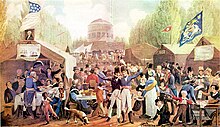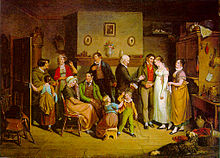John Lewis Krimmel
Initially influenced by Scotland's David Wilkie, England's William Hogarth, and America's Benjamin West, he soon turned to direct observation of life for his genre scenes.
Paintings such as Fourth of July Celebration in Centre Square (1811/12) and Election Day (1815) are filled with lively characterizations of scores of crowd members.
American artists influenced by Krimmel's work include William Sidney Mount, George Caleb Bingham, and Thomas Eakins.
The oil depicted a black woman ladling out bowls of her uniquely Philadelphian spicy soup to white customers of various ages and social classes.
Pavel Svinyin, a Russian on a diplomatic mission to Philadelphia between 1811 and 1813, apparently purchased roughly 14 sketches from Krimmel and presented them back in Russia along with works from a variety of sources as typical American scenes which he had painted himself.
Art historian Guy McElroy has identified this work as one of the first "to utilize physiognomical distortions [wide toothy grins and over-sized lips] as a basic element in the depiction of African Americans..."[1] Krimmel's depiction of a mother and daughter trying to persuade the drunken father to come home made Village Tavern the first American painting to illustrate the social ills addressed by the temperance movement.
From late 1816 to 1818, he travelled back to his home region as well as to Vienna and Salzburg, and his sketchbooks are filled with sketches of European landscapes, people, animals, and flowers.
He had also received a prestigious commission for a large historical work, a 6x9-foot canvas commemorating the landing of William Penn at New Castle, Delaware in October 1682.
While Krimmel's genre scenes found few buyers during his lifetime, engravings of his work made long after his death were widely circulated as prints and magazine illustrations.




